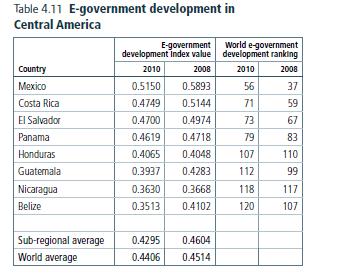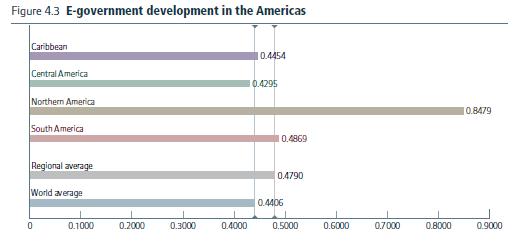Network Economy
ICT Employment Opportunities: Stage 3
Global technology companies and the government are making investments in local
support and service centers which has spurred a need for a skilled IT workforce.
The expansion and
modernization of the Panama Canal,
and
in particular,
a surge of call center operations has led to the creation of a large
number of jobs in ITC.
IT positions are hard to fill because the majority of workers in Panama
are largely unskilled, making it difficult to develop and expand IT-related
work. Panama has a high literacy
rate, but much of the literate workforce tends to move to low-skilled career
paths in traditional agricultural and service sectors rather than to IT,
creating a labor force imbalance. The laborers that are skilled and have
bilingual abilities are in demand, and there is competition for their employment
which has caused immigration from other parts of the world to fulfill the
employment needs.
As an example, information technology leader, Dell Inc., moved call center
operations to Panama in 2003 to take advantage of tax laws. Initially Dell
employed 500 workers, but that number has grown to over 2,000 and it is
estimated that Dell puts around $60 million a year back into the Panamanian
economy. Dell recently announced that it is investing an additional $13 million
its Panama operations which will increase even more the demand for skilled
workers.
While some corporations, such as Dell, participate in programs which help to
bring state-of-the-art technology into underserved communities and works with
organizations to teach information and communication technology (ICT) skills,
there needs to be a more concerted effort by both government and education to
improve the opportunity for ICT education and provide incentives to attract more
Panamanians to the ICT workforce.
Although there are some ICT opportunities, Panama had been given a stage
3 for ICT employment because in general Panama has not targeted IT services as a
target development industry and there are few special incentives aimed
specifically at this industry.

Business-to-Consumer (B2C)
Electronics Commerce: Stage 2
There are various factors that contribute to a regions e-Commerce use and growth
and include consumer behaviors; perception and demand; computer and internet
penetration and safety. Recent surveys by
Visa and comScore have highlighted that there has been significant growth that
has occurred in the Latin American in general over the last few years in the B2C
e-commerce market, but there are still significant barriers that must be
overcome before consumers fully embrace shopping online. One of the top reasons
that Latin Americans don’t shop online is concern about payment security,
followed by a preference for bricks-and-mortar stores.
Some of the area’s largest stores have put greater emphasis
on internet sales, but it is estimated that only 50% of the retailers in Latin
America have an online strategy. According to a report on the
e-commerce readiness for Latin America in general, it has
been estimated that e-commerce has grown by 47% between the years of 2006 and
2010. The growth in Panama has been at a much slower rate due partially to a
very low level of internet penetration, with only 30% people currently
connected. Another problem is a
concern about payment security and the fact that many sites don’t offer
alternatives to credit card payment. Many Latin Americans don’t have credit
cards and in order to make online purchases, retailers need to offer payments
via bank transfer or cash-on-delivery.
Potential shoppers will be excluded from e-merchants who don’t provide
non-card-payment options.
An e-commerce readiness assessment completed in 2008 placed
Panama at a relatively low Potential Demand index when compared to other Latin
American countries. Panama’s had a lower
indicator for infrastructure and technology adoption so there are significant
obstacles that must be overcome if e-commerce is to prosper, however the
potential is estimated to be huge.

Business-to-Business (B2B)
Electronic Commerce: Stage 3
There are numerous Panama is a zero tax jurisdiction, which provides
many benefits for e-commerce businesses. Panama has passed favorable legislation
to encourage international businesses to incorporate in Panama, especially
e-commerce. In Panama, e-commerce businesses are exempted from contributions,
duties or import fees on many items, national direct tax on capital and are also
exempt from income tax.
There is an increasing number of companies which are supplying
e-commerce solutions to the Panama business community, and because of Panama’s
geographical location, its good telecommunications links, and ICT
infrastructure, there is the potential to make the country a strong competitor
on the world
e-commerce market.
However, there is still much that needs to be developed and perfected in this
area.
E-Government: Stage 3
The Panamanian government has several initiatives under way to boost access to
the internet by providing free access for all and also an initiative to
digitalize governmental procedures.
Going into 2010 the internet penetration level for Panama was very low, with
only 28% people currently connected. But as a result of the government’s
‘Internet for All’ project, the penetration is expected to grow further in 2012.
Panama became one of the first countries in the world to offer free wireless
broadband access nationwide, with plans to reach 80% of the population.
The “Internet for All” project aims at providing free internet access to all via
connection points in libraries, schools, museums, as well as outdoor locations
such as parks and tourist attractions. The government is encouraging all
citizens to take advantage of the internet which will result in population that
is more internationally connected.
The government has also announced an initiative, involving a $415 million dollar
investment that will digitalize the governmental procedures and achieve what is
called the “E Government (government without papers)” by 2014.
Based on the United Nations
e-Government Readiness Index 2010, Panama ranks in the middle of readiness for
Central America. Panama is moving in the right direction with the
E Government initiative and within the next few years should improve its ranking
on the E-government readiness index.
 
|